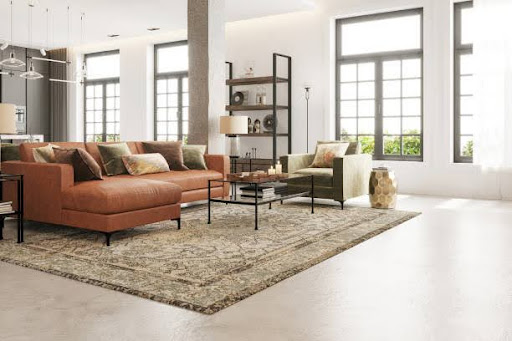A rug can do wonders for your dwelling area, adding warm temperature, texture, and a pop of coloration. But what if the appropriate carpet in your room is outside the marketplace? Fear not! With a touch of creativity and elbow grease, you may create a one-of-a-kind rug that is as unique as your own home. This put-up is your complete manual to weaving a private touch into your home decor. We’ll walk you through the manner from start to finish, sharing pointers, tricks, and design ideas along the way. Start scrolling, and you’ll be ready to roll out your very personal DIY designer rug by the time you quit.
Setting the Scene with Inspiration
Before you begin reducing or weaving, drawing a proposal on your rug’s layout is critical. Look at the colors and patterns for your room—are there any elements you would like to echo on your rug? Are you going for a bohemian appearance with rich, earthy tones or a minimalist design with a monochromatic scheme?
Finding Your Inspiration
Gather inspiration from numerous assets. Pinterest is a treasure trove of indoor design forums that let you refine your imagination and prescience. Natural elements like the sky, the sea, or sundown can also inspire your shade palette.
Anchor in the Aesthetic
Decide on a culture that suits your style. Consider the overall look you need to reap. Playful and vibrant? Serene and complicated? This will guide your layout picks and make the creation manner extra established.
Choosing Your Materials
Rugs can be crafted from various substances, each lending a unique appearance and feel for your advent. Multiple selections will affect the final product from the thread being counted to the pilot.
Picking the Right Fabric or Yarn
You might opt for rugged jute for its durability or soft chenille for its luxurious feel. When selecting your materials, consider the rug’s intended use, too. High-traffic areas will need a more hard-wearing fabric.
Thread Count Matters
Remember, a better thread to be counted generally approaches a softer, more luxurious rug. However, a lower thread being counted can offer a more excellent textured look and a sturdier weave.
Rug-Ready Space
Space is crucial for rug-making. You’ll need enough room to lay out your materials, cut and weave, and space out the rug as it grows.
Preparing Your Workspace
Clear a large, flat area for your project. If you’re using a loom, assemble it ahead of time. Good lighting is essential for detailed work; a comfortable chair will make long projects more manageable.
Organizing Your Materials
Keep all your materials, equipment, and reduced portions organized and near to hand. It’s smooth to lose track of small gadgets when you’re in the throes of creative work.
Preparation and Designing Your Rug

Before you start crafting, a bit of prep goes a long way. Measure your area to decide the ideal rug size, and mark it at the ground if vital.
Measuring Twice
Cutting once is the golden rule for any DIY project. Measure your materials and your project space multiple times to ensure accuracy.
Design on Paper First
If your rug features a pattern, drawing it out on graph paper is helpful. This will help you determine the needed materials and simplify the weaving process.
Making Your Mark
With your design in hand, it’s time to make your mark. This step involves cutting the materials to the correct lengths and preparing them for weaving.
Cutting the Rug Materials
Use a rotary cutter and measuring tool to make straight, precise cuts. Ensure all your pieces are uniform to avoid lopsided sections in the final product.
Preparing for Weaving
If you’re using a loom, thread it according to your design. For non-loom weavers, prepare your work surface by attaching the base materials securely and at the desired width.
The Weaving Process
Weaving your rug is when the magic occurs. It’s the maximum time-ingesting component, but it is also wherein you deliver your design to life.
The Over-and-Under
Start with the “over and beneath” approach for a basic weave, alternating each row. For more intricate styles, you will want to research unique weaving techniques, which include twill or herringbone.
Adding in Color
Change hues with a way called “weft or warp interlocking.” It sounds complex, but it is essentially laying the new shade thread down and weaving over and below as earlier than “locking” the antique coloration into the weave.
Finishing Touches
Once your weaving is complete, it is time to feature the completing touches to flip your rug right into a finished product prepared on your floor.
Securing the Weave
Tightly steady your last few rows to prevent the rug from unraveling. You can do this by weaving the lower back through a previous couple of rows or using a backstitch approach.
Trimming and Tidying
Trim any stray threads and smooth up the perimeters of the rug. You want everything to appear neat. This additionally guarantees that the carpet lies flat while positioned on the floor.
The Unveiling
With your rug complete, it is time to roll it out and respect your handiwork. There’s something pretty gratifying about seeing a rug you’ve made liven up your dwelling area.
Placing and Proudly Displaying
Find the ideal spot for your rug. It might be underneath your eating room table, in the center of your residing room, or even as a decorative tapestry. Your DIY rug is undoubtedly a communication starter wherever it goes.
Spread the Word
Share your DIY rug adventures on social media. It is an extraordinary way to document your process, but it may inspire others to innovate with their domestic decor.
Sharing Your Success
Post photos of your manner and completed rug. Be sure to percentage any pointers and tricks you found along the way, and do not be shy about admitting any mistakes—your revel in can be valuable to others.
Ready to Rug?
The DIY designer rug is a splendid venture that can remodel your dwelling space. With the proper materials, workspace, and a bit of innovative energy, you could craft a rug that is not handiest but however uniquely yours. It’s a private contact that no save-offered rug can match.
So, are you prepared to take the plunge and weave your creative vision into fact? Pull up your sleeves, pick your styles, and begin designing the rug to tie your room collectively.
Frequently Asked Questions (FAQs)
Is it hard to make a rug?
Although it is tricky for novices, making rugs is a skill that can be learned with persistence and exercise. The design and technique employed decide the level of complexity. Start with a simple design to simplify the method, then paint your way up to more complex styles as you increase self-assurance.
How do people make rugs?
Numerous techniques can create rugs, including knitting, crocheting, tufting, and weaving. The traditional approach uses a loom to weave yarn or cloth through a foundation material. More modern strategies could involve inserting yarn through a prefabricated basis with a tufting gun.
What material do you use to make a rug?
The rug’s intended function and desired aesthetic will decide the fabric selection. Typical substances include:
- Jute or bamboo for environmentally pleasant solutions.
- Cotton for easy washing.
- Synthetic fibers for stain resistance.
- Wool for warmth and sturdiness.
How do you make a rug without a gun?
You may make rugs without a tufting gun using knitting, crocheting, or traditional loom weaving. While crocheting and knitting employ a single needle or needles to make the loops of yarn that form the rug, weaving involves weaving threads over and beneath each other.

